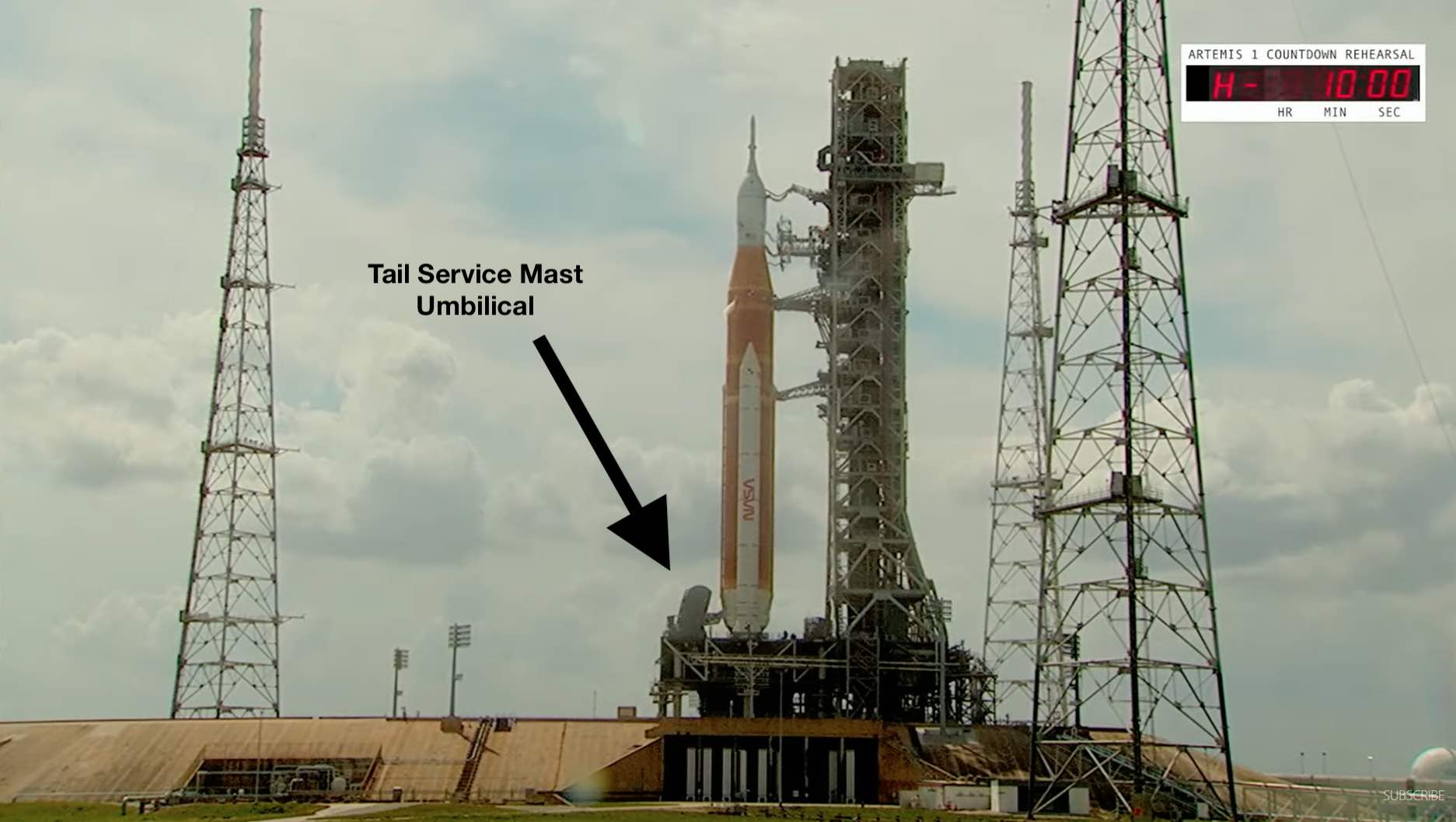
Technicians at NASA’s Kennedy Space Center will repair a leak in a liquid hydrogen fueling line on the Artemis 1 moon rocket the launch pad rather than inside the Vehicle Assembly Building, a decision the agency says will enable teams to test the repair under cryogenic conditions.
NASA’s launch team detected a leak in a quick-disconnect fitting on an 8-inch liquid hydrogen line during a launch attempt Saturday, forcing managers to stop the countdown. The leak was in a similar location but more significant than hydrogen leaks encountered during previous tankings of the huge Space Launch System moon rocket.
Ground teams at Launch Complex 39B will replace the seal on the quick-disconnect interface where the liquid hydrogen fueling line from the mobile launch platform hooks up to a hydrogen line on the core stage of the Space Launch System.
Technicians will erect an environmental enclosure around the work area at the tail service mast umbilical, gray housings that stick above the deck of the mobile launch platform to feed liquid hydrogen and liquid oxygen into the rocket. The tent will protect sensitive components in the umbilical area from weather and contamination.
NASA officials said after Saturday’s scrubbed launch attempt that they were considering options to repair the hydrogen leak at the pad or inside the Vehicle Assembly Building, which would require the rocket to roll the 4.2-mile (6.8-kilometer) distance back to the hangar on a diesel-powered crawler-transporter. A benefit of repairing the leak at the pad is that the launch team will be able to confirm the tightness of the umbilical seal under cryogenic conditions.
Teams will flow super-cold liquid hydrogen, chilled to minus 423 degrees Fahrenheit, through the umbilical line to see if it still leaks. The shape and size of seals and gaskets can change when exposed to super-cold temperatures, creating a leak path that wasn’t detectable at ambient temperatures. A molecule of liquid hydrogen, created by bonding two hydrogen atoms together, is one of the tiniest known in the universe, and leak through gaps impermeable to other molecules.
The SLS moon rocket’s core stage contains 537,000 gallons of liquid hydrogen fuel and 196,000 gallons of super-cold liquid oxygen as an oxidizer. The same propellants power the SLS upper stage, with much smaller tanks.

NASA said ground teams at pad 39B will check plate coverings on other umbilical interfaces to ensure there are no other leaks. “With seven main umbilical lines, each line may have multiple connection points,” NASA said in an update posted late Tuesday.
Even with the leak repair at the launch pad, the 322-foot-tall (98-meter) moon rocket may still have to return to the Vehicle Assembly Building. The U.S. Space Force’s Eastern Range — responsible for public safety for all launches from Kennedy Space Center and Cape Canaveral Space Force Station — has certified the moon rocket’s flight termination system batteries for 25 days, a life cycle that expires this week.
NASA is expected to ask the range to extend the certification of batteries on the flight termination system, which would destroy the SLS moon rocket if it veered off course and threatened populated areas during launch. The Space Force has already agreed to an extension from 20 to 25 days, enabling Artemis 1 launch attempts through all possible dates in the mission’s previous launch period, which ended Tuesday.
If the Eastern Range does not agree to another extension, NASA will have to reset and re-test the flight termination system. That work must occur inside the Vehicle Assembly Building.
A rollback to the VAB would delay the Artemis 1 launch until at least mid-October, but NASA could be in a position for another launch attempt later this month if the moon rocket remains on pad 39B. The next launch period opens Sept. 19 and runs through Oct. 4, followed by another series of launch dates from Oct. 17 through Oct. 31.

The Artemis 1 mission will mark the first test flight of the SLS moon rocket, the most powerful launcher to ever lift off from U.S. soil. Its four main engines and two solid rocket boosters are leftover designs from the space shuttle program. The engines and boosters will generate 8.8 million pounds of thrust at launch, about 15% more power than the Saturn 5 moon rocket from the Apollo program.
The Space Launch System will send a human-rated Orion crew capsule on an unpiloted shakedown cruise around the moon. The Orion spacecraft will fly just 60 miles (100 kilometers) from the lunar surface and swing into a distant retrograde orbit, then fire its engines to begin a return course to Earth, culminating in a parachute-assisted splashdown in the Pacific Ocean off the coast of San Diego.
If it goes well, the test flight will pave the way for four astronauts to strap in to the Orion capsule on the Artemis 2 moon flyby mission, currently scheduled for launch in 2024. Future Artemis missions will include commercial lunar landers to ferry astronauts to and from the surface of the moon.
Email the author.
Follow Stephen Clark on Twitter: @StephenClark1.
from Spaceflight Now https://ift.tt/UgsJqZx
via World Space Info







0 comments:
Post a Comment